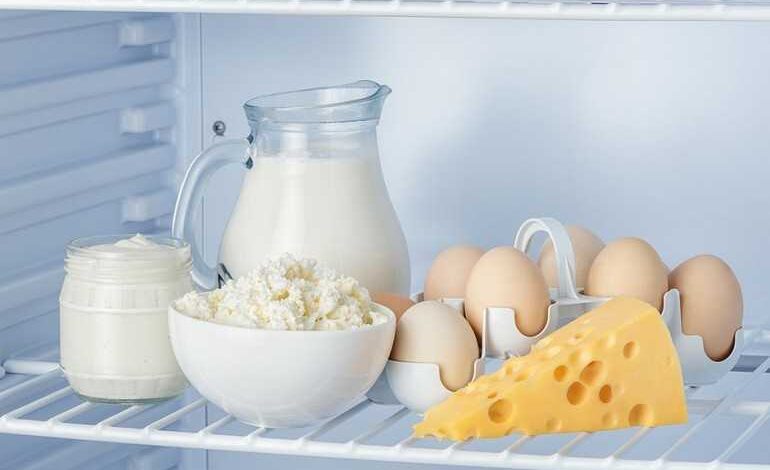How To Store Milk And Dairy Products

Dairy refers to food products that are made from the milk of mammals, such as cows, goats, and sheep. In addition to milk, dairy products include cheese, butter, yogurt, ice cream, and other products made from milk.
Milk is a primary source of dairy, and it is used in a wide range of food products. It contains many essential nutrients, including calcium, protein, vitamins, and minerals, that are important for building and maintaining strong bones and teeth, supporting muscle growth and development, and promoting overall health and wellness.
Dairy products are an important part of many people’s diets, but they may not be suitable for everyone. Some people may be lactose intolerant, which means they have difficulty digesting lactose, a sugar found in milk and dairy products. In these cases, alternative sources of calcium and other nutrients may be necessary.
In recent years, there has been a growing interest in plant-based alternatives to dairy products, such as soy milk, almond milk, and coconut milk. These products are often fortified with calcium and other essential nutrients and may be suitable for individuals who are lactose intolerant or who choose to follow a vegan or vegetarian diet.
Overall, milk and dairy products can be a healthy and nutritious part of a balanced diet, but it’s important to choose products that are low in fat and added sugars and to consume them in moderation
How Long Can Milk Be Stored
Fresh milk
Fresh (home-made) milk has now become a rarity. A couple of decades ago, in every yard, in every village there was one or two cows and fresh milk was constantly milked, so there was no particular need to store it for a long time.
Some were curdled, something was rented or sold. Today, urban residents can still buy such milk “from under the cow”, but you need to know how to store it:
- if the hostess is clean, the cow is healthy, then fresh milk can be stored for up to two days in a refrigerator or cellar. The temperature should not exceed +6ºС. It is best to use glass containers and nylon lids;
- after boiling, you can add another day, in a cold place;
- without a refrigerator at room temperature, you can leave a jar of milk for 8-10 hours without fear that it will turn sour. Unless, of course, we are talking about hot summer weather.
pasteurized milk
Milk is pasteurized by a single short-term heating at a temperature below 100ºС. This method of disinfection is the most popular and widely used in dairies. The shelf life is always indicated on the packaging:
- closed package at temperatures up to +40C is stored for 10 days, provided that the packaging is not damaged;
- after opening, the period is halved.
Sterilization
This is a treatment not only with temperature (125-145ºС) for 3-10 seconds, but also with increased pressure:
- sterilized milk after cooling is packaged in tetra packs. Closed containers are stored for a long time, up to six months, and at any temperature. This is due to the complete destruction of the pathogenic flora and its spores;
- The opened package should be refrigerated and the product should be used within 1-2 days.
UHT milk
If the processing is carried out at a temperature of 125ºС for 2-4 seconds, then we are talking about ultra-pasteurization. The shelf life in this case is the same as for pasteurization.
Baked milk
Baked milk is distinguished by its color (creamy beige) and rich taste. For its preparation, raw materials are placed in special vats, heated to a temperature of 980C and kept for several hours.
However, baked milk is a perishable product, so you need to store it in the cold. An open package should be used no longer than 5 days.
How Long Can Dairy Products Be Stored
Kefir
The shelf life of kefir after it has been opened it about 5-14 days, depending on weather it has been pasteurized or not. Unpasteurized kefir should be consumed within 5-7 days after opening it whereas pasteurized kefir can last for about 14 days but only when stored in the refrigerator.
curdled milk
One of the tastiest and healthiest fermented milk products, curdled milk, is easy to prepare. It can be done quite easily by adding a few tablespoons of fat sour cream to hot milk and sweating at a temperature of 60-700From to the formation of homemade curdled milk. If you add the starter and hold it a little longer, you get homemade yogurt.
After the yogurt has cooled, it must be poured into sterilized glass jars and stored in the refrigerator for up to five days.
Sour cream
The fat content of sour cream from modern manufacturers ranges from 10 to 25%. But regardless of the fat content, the product should not contain artificial additives and preservatives.
Most often, sour cream is packaged either in film or in plastic cups. The shelf life, usually indicated on the package, is 10 days. We are talking about closed undamaged packaging and storage in the refrigerator.
After the package is opened, it is recommended to transfer the sour cream to a glass jar, tightly close the lid and store for no longer than 2-3 days. You can leave sour cream in a plastic cup and do not transfer it, provided that a tight lid is attached to the cup.
If sour cream is packed in glass containers, then it can be stored in this form.
Homemade sour cream from fresh milk turns out to be more fatty, it is stored in the refrigerator for 3-4 days.
Cottage cheese
Regardless of fat content, cottage cheese is stored in the refrigerator for two to four days. It is advisable, after purchasing, to open the original packaging and transfer the cottage cheese to a glass jar (or an enameled bowl) and close tightly.
If you first hold a pack of cottage cheese for several hours in the freezer, and then transfer it to the “coldest” compartment of the refrigerator, then the shelf life can be increased to 5 days. However, you should not abuse it, cottage cheese is a rapidly perishable product.
Cheese
- Hard cheeses are recommended to be stored in a plastic wrap or bag, previously wrapped with parchment. A whole head of cheese will keep in the refrigerator for up to two months. Separate cut pieces, packaged in an appropriate way, are only up to a month. Hard cheeses include peasant, smoked, moldy cheeses. These are best additionally packed in a plastic container so that neighboring products are not saturated with a specific smell. Hard also includes Swiss, Dutch cheese, parmesan.
- Soft cheese keeps in the refrigerator for about two weeks. It also needs to be wrapped in paper. Cheese should be stored in a cold compartment, ideally in a vegetable drawer. Before serving, you need to leave the cheese for half an hour at room temperature so that it fully returns its taste.
In conclusion, storing dairy products properly is important to maintain their freshness, quality, and safety. Here are some key points to keep in mind:
- Milk should be stored in the refrigerator at a temperature between 1-4°C (33-39°F) and consumed within the expiration date.
- Once opened, milk should be consumed within a few days and stored in the refrigerator at all times.
- Dairy products like cheese, yogurt, and butter should also be stored in the refrigerator and consumed within their expiration dates.
- Cheese should be wrapped tightly in plastic wrap or wax paper to prevent it from drying out and developing mold.
- Yogurt should be stored in its original container and tightly sealed to prevent it from drying out.
- Butter should be stored in an airtight container or wrapped in foil or wax paper and stored in the refrigerator.
By following these guidelines, you can help to ensure that your dairy products stay fresh, safe, and delicious for as long as possible.




